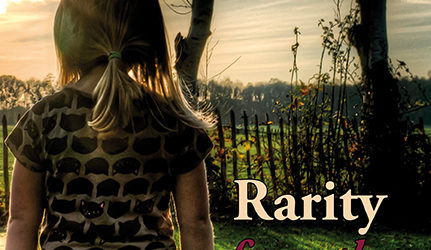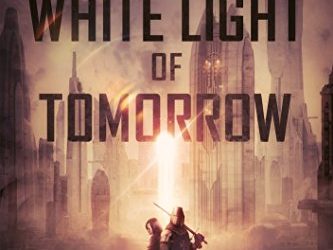About the book, Rarity from the Hollow 
- Paperback: 284 pages
- Publisher: Dog Horn Publishing; 2nd Revised edition edition (November 3, 2016)
Lacy Dawn’s father relives the Gulf War, her mother’s teeth are rotting out,and her best friend is murdered by the meanest daddy on Earth. Life in the hollow is hard. She has one advantage — an android was inserted into her life and is working with her to cure her parents. But, he wants something in exchange. It’s up to her to save the Universe. Lacy Dawn doesn’t mind saving the universe, but her family and friends come first.
Will Lacy’s predisposition, education, and magic be enough for her to save the Universe, Earth, and, most importantly, protect her own family?
Rarity from the Hollow is adult literary science fiction filled with tragedy,comedy and satire. It is a children’s story for adults, not for the prudish, faint of heart, or easily offended.
Praise for Rarity from the Hollow:
“The most enjoyable science fiction novel I have read in years.” —Temple Emmet Williams, Author, former editor for Reader’s Digest
“Quirky, profane, disturbing… In the space between a few lines we go from hardscrabble realism to pure sci-fi/fantasy. It’s quite a trip.” –Evelyn Somers, The Missouri Review
. “…a hillbilly version of Hitchhiker’s Guide to the Galaxy…what I would have thought impossible; taken serious subjects like poverty, ignorance, abuse…tongue-in-cheek humor without trivializing them…profound…a funny book that most sci-fi fans will thoroughly enjoy.” — Awesome Indies (Gold Medal)
“…sneaks up you and, before you know it, you are either laughing like crazy or crying in despair, but the one thing you won’t be is unmoved…a brilliant writer.” —Readers’ Favorite (Gold Medal)
“Rarity from the Hollow is an original and interesting story of a backwoods girl who saves the Universe in her fashion. Not for the prudish.” —Piers Anthony, New York Times bestselling author
“…Good satire is hard to find and science fiction satire is even harder to find.” — The Baryon Review
“…Brilliant satires such as this are genius works of literature in the same class as Orwell’s ‘Animal Farm.’ I can picture American Lit professors sometime in the distant future placing this masterpiece on their reading list.” — Marcha’s Two-Cents Worth
“…I know this all sounds pretty whack, and it is, but it’s also quite moving. Lacy Dawn and her supporting cast – even Brownie, the dog – are some of the most engaging characters I’ve run across in a novel in some time….” — Danehy-Oakes, Critic whose book reviews often appear in the New York Review of Science Fiction
“… The author gives us much pause for thought as we read this uniquely crafted story about some real life situations handled in very unorthodox ways filled with humor, sarcasm, heartfelt situations and fun.” — Fran Lewis: Just Reviews/MJ Magazine
Buy, read, and discuss Rarity from the Hollow:
Amazon | Barnes & Noble | IndieBound | Goodreads
About the author, Robert Eggleton
 Robert Eggleton has served as a children’s advocate in an impoverished state for over forty years. Locally, he is best known for his nonfiction about children’s programs and issues, much of which was published by the West Virginia Supreme Court where he worked from1982 through 1997.
Robert Eggleton has served as a children’s advocate in an impoverished state for over forty years. Locally, he is best known for his nonfiction about children’s programs and issues, much of which was published by the West Virginia Supreme Court where he worked from1982 through 1997.
Today, he is a retired children’s psychotherapist from the mental health center in Charleston, West Virginia, where he specialized in helping victims cope with and overcome maltreatment and other mental health concerns. Rarity from the Hollow is his debut novel. Its release followed publication of three short Lacy Dawn Adventures in magazines. Author proceeds support the prevention of child maltreatment. http://www.childhswv.org/
Connect with Robert:
Facebook | Goodreads | Twitter
My Thoughts
 I first read Rarity from the Hollow two years ago, when the author, Robert Eggleton contacted me and asked me to consider it. It seemed interesting, edgy and different, so I took a chance, and was immediately hooked on his concept and his story. I was supposed to review it then, life got in the way, and it was a year (and a revised edition) later before I wrote a review. Somehow, that review got eaten by WordPress, and after far too much patience on Mr. Eggleton’s part, I’ve rewritten it and am posting it now.
I first read Rarity from the Hollow two years ago, when the author, Robert Eggleton contacted me and asked me to consider it. It seemed interesting, edgy and different, so I took a chance, and was immediately hooked on his concept and his story. I was supposed to review it then, life got in the way, and it was a year (and a revised edition) later before I wrote a review. Somehow, that review got eaten by WordPress, and after far too much patience on Mr. Eggleton’s part, I’ve rewritten it and am posting it now.
Described as a ‘fairy tale for adults,’ this novel looks at PTSD, poverty, child sexual abuse and child murder – any one of which could be considered a trigger for most readers – wraps them in literary science fiction, and gives us a protagonist in Lacy Dawn (who is also the primary POV character) who is sensitive, spunky, inquisitive, and manages to contain within herself a combination of too much awareness and childish innocence that should not work, but strangely does.
Calling this novel a fairy tale or science fiction, while accurate, is also limiting, because it’s so much more than both. Parts of this story are quite tragic – when we first meet Lacy Dawn, she is coaching her best friend Faith on a spelling test, her father is abusive and her mother is battered in both body and spirit. Within a few chapters, Faith has been killed, but her spirit lingers and her relationship with Lacy Dawn does as well, but then, our heroine also talks to trees, understands her dog Brownie, and has an android boyfriend named DotCom who is also recruiting her for a business venture (no, nothing salacious).
(As an aside, DotCom is my favorite of the supporting characters – but that’s probably because of my decades old crush on Data from Star Trek: The Next Generation.)
In many ways, Rarity from the Hollow feels like a coming-of-age novel for adults. As we experience the end of true childhood and the beginning of adolescence with Lacy Dawn, we also confront the leftover issues from our own childhoods – our relationships with our friends and families, our own choices about sex and love and when to act on each, how we handled college and our first careers.
Unlike Lacy Dawn, we don’t have magical abilities or help from androids from other planets. We have to muddle through our lives in a world that is increasingly dangerous and frightening, but novels like Rarity from the Hollow give us the ability to engage in self-reflection while living vicariously through fictional characters. Author Eggleton has couched some very important truths in a story that is equal parts entertaining and provocative.
Not to be overlooked are some truly comic moments. DotCom’s anatomy changes as he moves toward an adult relationship and there’s a creative use of a laptop and the inner wish that perhaps he should have worn clothes that is described in a way worthy of a Monty Python sketch.
If you enjoyed Piers Anthony’s Mode series (which I haven’t read in over twenty years), or are a fan of the work of Douglas Adams (Not just The Hitchhiker’s Guide to the Galaxy. I’m addressing those who like Dirk Gently, also.) you will likely enjoy Rarity from the Hollow, because Robert Eggleton excels at mixing the absurd and nearly preposterous with the incredibly real. However, even if you’re not a fan of those authors, I still recommend this novel. It’s sharply written, well crafted, genre-defying, and totally worth the time spent reading it.
Goes well with anything you enjoy, but I’d recommend Mexican street tacos – the kind where you get a kilo of grilled steak and a stack of tortillas and fill them yourself – and a bottle of Indio or Negra Modelo beer.












